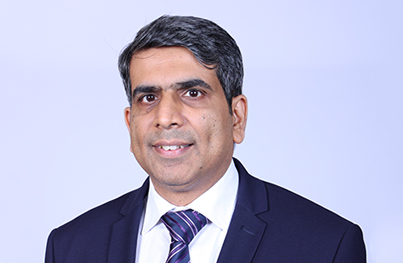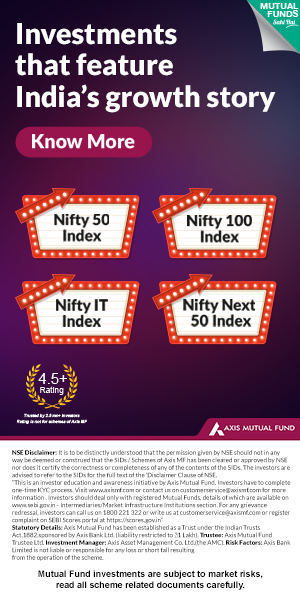Consumption Funds Can be Core of An Investors Portfolio
BFSI Industry Interview

Mr. Gautam is a Fund Manager with HSBC Asset Management, India. Currently, he manages HSBC Tax Saver Equity Fund, HSBC Infrastructure Fund, HSBC Business Cycle Fund and HSBC Managed Solutions. He has an experience of more than 19 years in the asset management industry and has been working with HSBC AMC for more than 15 years. Prior to joining HSBC in July 2008, Gautam worked as an Analyst with UTI Asset Management in India for more than 4 years. Gautam received an MBA from the Management Development Institute, Gurgaon, India and is also a Chartered Accountant and Company Secretary.
How would you describe your investment philosophy or style to an investor?
We consider “fundamental research” the foundation of my investment decision-making process. We look at scalable businesses with strong execution capabilities, proven management track records, strong financials, and sustainable growth potential. Valuation is also an important consideration, and we look at companie’s valuations relative to their peers as well as their history.
Although we also assess the overall macro environment and sectoral developments, stock selection is crucial for delivering alpha in the long run. Hence, we follow both top-down and bottom-up approaches but with more emphasis on the bottom-up approach.
For portfolio construction, we follow Index aware but not Index hugging strategy. We like to have an active share in the portfolio and try to minimise the churn.
Does investing philosophy or style have an impact when managing a thematic fund?
Broadly my investment philosophy or style does not change for a thematic fund. However, the importance of bottoms-up stock selection gets more pronounced. Further, thematic fund benchmarks typically tend to be very concentrated. Hence, there are more deviations and active shares compared to its benchmark in thematic funds.
Can you share with our readers the thesis behind the upcoming NFO - HSBC Consumption Fund?
Three main enablers will lead to a massive increase in consumption in the coming years.
The first enabler is accelerated growth in Income levels in the coming 10-15 years. India has reached an inflection point of GDP per capita of $2000, and when this happens, the consumer’s income and spending patterns start changing drastically. We have seen numerous examples like the US in the 1950/the 60s, Germany in the 1960s, Japan in the 1970s, South Korea in the 1980s, and recently China did it in the 2000s, where all the countries have seen that J-curve kind of growth once they cross this inflection point. The good part about this is that it has played out in many countries with different economic structures, cultures, history and across different time frames.
India is favourably positioned in terms of demographics and may reap the demographic dividend in the coming years. Number of Households having an income of Rs 5 lakh and above are expected to double in the next 10 year from the current 95 mn.
The second enabler is easier access to credit. There has been a substantial increase in access to credit in the last few years, particularly for small ticket items. Credit card spending has grown 12 times in the last 10 years. Easy access to credit will fuel further growth in consumption.
The third enabler is changing spending patterns. Over the last 10-15 years, we have observed that the avenues to spend have increased multi-fold with expansions in existing categories and the emergence of new categories. Further newer generation, i.e. Millennials and GenZ, tends to spend a lot more on consumption than the previous generation. They will be around 3/4th of the population by 2030, and this should lead to much higher consumption growth.
This gives us confidence that India should accelerate growth in consumption, particularly discretionary consumption, in the coming 10-15 years.
Which sectors and industries will form part of the consumption theme? Is your methodology based on exclusion criteria, i.e. certain types of businesses will be excluded, and the rest will be investing universe? Or will it qualify a company based on an inclusive list, i.e., only if it fulfils certain criteria can it be added to the portfolio? Or do you have a pre-defined sector list you categorise as a consumption theme?
NSE Consumption Index will be the benchmark of the portfolio, and at least 80% of the portfolio will be in sectors that are part of the benchmark. These sectors include FMCG, Auto, Consumer Durables, Consumer Services, Telecom, Healthcare, Real Estate etc. However, there are some sectors, like Financials, that are not part of the benchmark, but we may consider them to be part of the fund up to 20% as they are key enablers of consumption in India. At a broader level, we may consider B2C companies and exclude B2B companies.
Consumption theme has always been traded at a premium in India; how easy or difficult will stock picking be, given the consistently high valuations?
Consumer-oriented companies, especially the FMCG sector, have strong brand loyalty, and hence they have relatively more consistent revenue and earnings growth. They typically have a strong balance sheet and generate a reasonable return on capital. Because of these characteristics, they tend to trade at a premium.
Hence, though some of these companies may have consistently traded at higher valuations compared to the broader market, that may still be justified based on their fundamental attributes and growth prospect. Also, we look at valuations relative to its peers as well as its history. Hence, normally we search for opportunities in this space.
Based on your methodology, what percentage of large-cap, mid-cap and small-cap will form the universe?
We have seen that typically most diversified or thematic indices are biased towards large caps. If we look at, say NSE 500 index, large caps currently have around 75% weight. We believe that there are equally good opportunities in mid-cap and small-cap. Hence, we will have more diversification relative to Index, not only in terms of sectors but also in terms of market cap, and we plan to have a good representation of mid-cap and small-cap in the fund.
Will you be taking foreign exposure in the fund? How much can that be in your portfolio, i.e. after the industry limit is increased for foreign investing?
The key theme of the fund is India’s consumption growth over the next 10-15 years. So, we will mostly focus on companies that have a consumer base in India. Hence, at this point in time, we will mostly look at companies listed in India.
In your view, what period should an investor remain invested in this fund?
We believe that India is currently in a sweet spot where it might see accelerated growth in consumption for the next 10-15 years. Hence, my advice to an investor would be to have a long-term approach towards the consumption theme and keep this Fund as a core part of their portfolio.
In your view as a fund manager, if an MFD is asked by an aggressive investor on what percentage of a portfolio can one consider for a thematic fund like this which will have many years to fully evolve, so what percentage of the portfolio can be considered to such a theme?
Allocation of funds to a client portfolio should be based on sound financial planning, which should include an assessment of various factors like risk profile, age, investment horizon etc. Hence, it will be very difficult to generalise and specify a specific percentage. However, as said earlier that this is a long-term theme. Also, if we look at the average volatility of the NSE Consumption Index over the last 10 years, it is lower relative to diversified indices like NSE 500 or NSE 50 and also lower relative to other sector indices. Hence, we believe that consumption funds can become part of every investor’s portfolio.
HSBC Consumption Fund
An open-ended equity scheme following consumption theme

Mutual Fund Investments are subject to market risk, read all scheme related documents carefully
CL 508
Disclaimers:
This document has been prepared by HSBC Asset Management (India) Private Limited (HSBC) for information purposes only with an intent to provide market overview and should not be construed as an offer or solicitation of an offer for purchase of any of the funds of HSBC Mutual Fund. All information contained in this document (including that sourced from third parties), is obtained from sources, which HSBC/ third party, believes to be reliable but which it has not been independently verified by HSBC/ the third party. Further, HSBC/ the third party makes no guarantee, representation or warranty and accepts no responsibility or liability as to the accuracy or completeness of such information. The information and opinions contained within the document are based upon publicly available information and rates of taxation applicable at the time of publication, which are subject to change from time to time. Expressions of opinion are those of HSBC only and are subject to change without any prior intimation or notice. It does not have regard to specific investment objectives, financial situation and the particular needs of any specific person who may receive this document. Investors should seek financial advice regarding the appropriateness of investing in any securities or investment strategies that may have been discussed or recommended in this report and should understand that the views regarding future prospects may or may not be realised. Neither this document nor the units of HSBC Mutual Fund have been registered in any jurisdiction. The distribution of this document in certain jurisdictions may be restricted or totally prohibited and accordingly, persons who come into possession of this document are required to inform themselves about, and to observe, any such restrictions.
This document is intended only for those who access it from within India and approved for distribution in Indian jurisdiction only. Distribution of this document to anyone (including investors, prospective investors or distributors) who are located outside India or foreign nationals residing in India, is strictly prohibited. Neither this document nor the units of HSBC Mutual Fund have been registered under Securities law/Regulations in any foreign jurisdiction. The distribution of this document in certain jurisdictions may be unlawful or restricted or totally prohibited and accordingly, persons who come into possession of this document are required to inform themselves about, and to observe, any such restrictions. If any person chooses to access this document from a jurisdiction other than India, then such person do so at his/her own risk and HSBC and its group companies will not be liable for any breach of local law or regulation that such person commits as a result of doing so.
Mutual Fund Investments are subject to market risk, read all scheme related documents carefully
HSBC Asset Management (India) Private Limited, 9-11 Floors, NESCO IT Park, Building no. 3, Western Express Highway, Goregaon (East), Mumbai – 400 063, India.
investor.line@mutualfunds.hsbc.co.in | Website: www.assetmanagement.hsbc.co.in
Recent Interviews
-
In conversation with Mr Manish Gunwani Head Equities with Bandhan Mutual Fund
Apr 17, 2024
-
In conversation with Mr Aniruddha Naha CIO Alternatives of PGIM India Asset Management Pvt Ltd
Apr 15, 2024
-
In conversation with Mr D P Singh Deputy Managing Director and Joint Chief Executive Officer of SBI Mutual Fund
Mar 25, 2024
-
In conversation with Mr Anunaya Kumar President and Head of Sales and Distribution at 360 ONE Asset
Mar 21, 2024
-
In Conversation with Mr Gautam Kaul of Bandhan Mutual Fund: Senior Fund Manager Fixed Income
Mar 13, 2024
Fund News
-
Aditya Birla Sun Life Mutual Fund launches Aditya Birla Sun Life Fixed Term Plan Series UU: 98 Days
Apr 30, 2024 by Advisorkhoj Team
-
HDFC Mutual Fund launches HDFC Manufacturing Fund
Apr 26, 2024 by Advisorkhoj Team
-
Edelweiss Mutual Fund launches Edelweiss Nifty Alpha Low Volatility 30 Index Fund
Apr 26, 2024 by Advisorkhoj Team
-
Kotak Mutual Fund launches Kotak FMP Series 330
Apr 25, 2024 by Advisorkhoj Team
-
Groww receives SEBI approval to launch Indias first Nifty Non-Cyclical Consumer Index Fund
Apr 24, 2024 by Groww Mutual Fund




